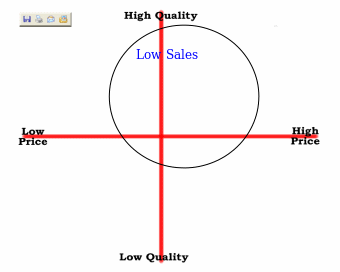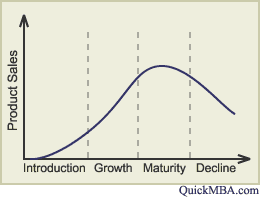Introduction
Perceptual mapping refers to a visualization method devised by marketing professionals to make graphic perceptions and visualizations of a perceived marketing problem scenario demanding a feasible marketing strategy as a way of instrumenting a turnaround. Perceptual mapping becomes handy when it is also used to make up graphic displays of the perceived or established perception of consumers on particular products or services. The perceptual maps consist of two or more dimensions that are used to form a framework where product or services features such as consumer perceptions, popularity, marketed segmentation can be located as a way of arriving at a clearer understanding of the market and product/service performance.
Simulation; Graph and Summary
Cruiser Thorr is a multi Billion Dollar firm which trades in the production of arranging of motorcycles. The company has produced more than 150 000 units so far in 2008. The problem scenario is based on the decline of sales of Thorr Motorcycles. A perceived relationship between product price and quality is perceived to be central to the problem scenario based on plummeting product sales. In order to execute a feasible strategy aimed at turning around the company’s profitability, Thorr Motorcycles must transform the images created by consumers on its products. The Perceptual map that presents the relationship between two simulation parameters which are product price and quality has helped to devise a feasible marketing strategy to up the company’s profitability endeavors by restoring and increasing profitable sales volume.
Three phases
The three major phases of the simulation entail problem identification which in this case is an undesirable drop in sales. The second stage is the formulation of a marketing plan based on the nuances derived from the simulation and perceptual maps. The final stage entails the evaluation of results and authenticating of the marketing for the implementation of the identified and established positioning strategy.
The simulation graph below illustrates the relations between the Thorr motorcycle products market performance in relation to the two dimensions that have been selected for the simulation process. The two parameters that have been selected for this simulation are price and quality.
Simulation Graphs Dimensions (Perceptual Map)

Perceptual Mapping and Simulation
Three has been noted a detrimental trend in the relationship between product price and quality. The perceived pattern envisaged in the perceptual map indicates that there is a concentration of purchases on motorcycles products of comparatively lower quality and which are comparatively cheaper. This necessitates the consideration by the marketing organs of the company for the formulation and implementation of feasible means of marketing and repositioning higher quality products in order to restore as well as increase profitable sales volumes.
Marketing Components
Whilst Thorr has a clear thrust on product differentiation across its high quality and low-quality product ranges, the company must take measures towards further differentiation especially its high-quality products in order to consolidate its profitable market share in face of stiffening competition. Chekitan S. Dev et al (2005) concur that “Customers should have a particular reason for purchasing from your firm and that purchase reasoning comes from the positioning and differentiation aspects of marketing.”
In marketing, strategy differentiation is perceived as the constitution of distinction between two or more products and services. In the end, Mootee (994), presents the following definition of positioning. He defines positioning as, “The locations of the product or services in an advantageous position.”
The simulation suggests that because of the lack of appropriate and adequate differentiation of Thorr Motorcycles’ high-quality products, the products are well-positioned to weather the stiff competition posed by other companies providing similar top-of-the-range products. This has been the noted relationship between differentiation and positioning in this simulation.
The repositioning of the Thorr products in the simulation is suggesting the feasibility of the assembled marketing strategy basing on the implications of the simulation.
The repositioning in the simulation based on successful differentiation on the product image and quality has seen the increase in the purchase of the high-quality products of the company which has restored sales to profitable volumes in the simulation.
The Impact of Product life cycle
In marketing, The Product Life cycle refers to the stages through which a new product will go. The stages are introduction, growth maturity, and decline.
The product or service revenue can demonstrated be on a graph as shown below in relation to the product/service location in the cycle.
The product life cycle is a marketing conceptual and application framework that highlights the dynamics of various stages that a product goes through. Product life cycle (PLC) relates to the life track of a product or service in the market in close relation to costs and sales proportion and measures for the business and or commercial aspects. PLC has helped the in development of the management and valuations of product or serviced performance in the market and by larger purports to help marketers formulate feasible and effective strategies that will help consolidate product and service position sin the market to protect or ensure or even increase a product’s performance in the objectives of keeping profitability margins. PLC framework culminates from considerations that a product has limited life and that the product will go through different stages that will present dynamic and distinct challenges. By extension consideration also include that at some point in the product’s life cycle profits will rise and drop at some points within the cycle. The other consideration leading to the framing of the PLC model is based on the fact that products and services demand different and effective marketing, purchasing, and manufacturing as well as personnel strategies in every life cycle phase.
The market introduction stage normally consists of high costs and low sales volume and focuses on demand creations. The second stage which is the growth stage entails cost reductions under the influences of the economies of scale. This stage is marked by a significant rise in sales volume. This stage is also marked by heightening consumer awareness. The maturity stage is marked by low costs as the products get more established and need no public awareness. The final stage which is the decline or saturation stage is marked by a decline in sales volume and the diminishing of prices. As such in this stage costs become counter-optimal.

Thorr Motorcycles has been in operation for decades and the impact of the decline stage of the product life cycle is taking its toll on the company’s sales volumes. Most of the company’s high-quality products are old models which have outlived the growth and maturity stages. Thorr Motorcycles has to consider the aspect of Lifestyle image in its turnaround marketing strategy aimed at revamping and reviving its top-of-the-range motorcycle products. The image will edge customers to purchase the company’s high-quality products hence increase sales and restore the company’s performance to profitability.
References
Chekitan S. Dev and Don E. Schultz, Marketing Management (2005), Milleniumm Publishers, UK, p, 34.
Guiltinan et al, McGraw Hill/Irwin, (1996 ), “Marketing Management: Strategies and Programs”, NYK Books, p 342.
Mootee, (1994), The Concept of the Marketing Mix”, (2001) from the Journal of Advertising Research, High Intensity Marketing. SAPress, pp 2-7 I.
